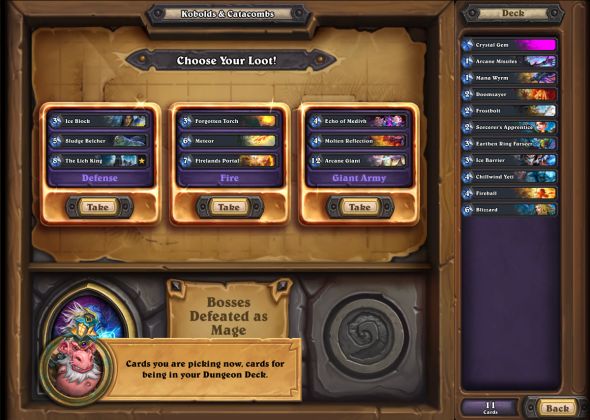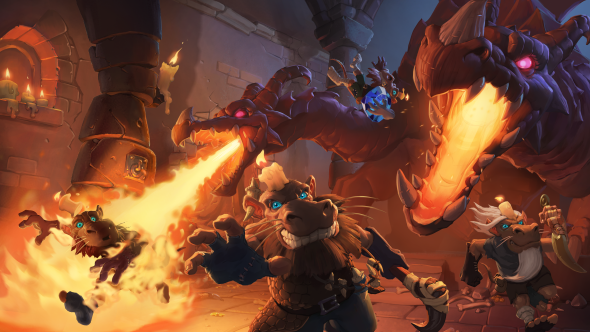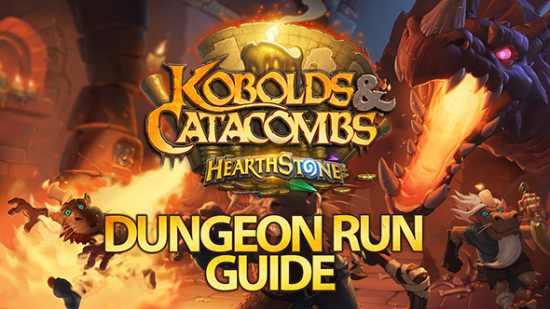Blizzard are introducing a completely new way to play Hearthstone with Dungeon Run mode – a single-player adventure that pits you against a series of eight powerful bosses. The free mode selects encounters from a pool of 48 potential bosses, meaning the possible combinations of encounters and decks that you can play run into the hundreds.
Dungeon Run is part of the new Hearthstone Kobolds and Catacombs expansion.
Hearthstone Dungeon Run bosses and encounters
The system is designed to be infinitely replayable, and the difficulty certainly helps that: if you die in Dungeon Run, the entire session is over. Some bosses are even “rare spawns” that won’t trigger as often as others, and are often a little bit weirder than more standard bosses.

Below is a list of all the currently known bosses along with their hero powers. Bosses are separated into pools, governing when in the dungeon run you can encounter them. Initially it was believed there were only three pools – first bosses, middle bosses and last bosses – but it appears to be a bit more complicated than that. Once we’re able to actually play it, we’ll know more.
For now, here’s a list of all the bosses we’ve seen so far, and where they’ve shown up. We would track health values, but this appears to be more dependent on when you encounter them, rather than the actual boss itself – the first has 10, the second 15, the third 20, and so on. By the end of a run you will have 50 HP and the final boss will have 70.
- Early bosses – first three.
- Giant Rat
- Rat Race (2 mana): Summon two 1/1 Rats.
- Wee Whelp
- Unknown.
- Graves the Cleric
- Light’s Will (0 mana): Restore 2 Health to all minions.
- Frostfur
- Freeze (2 mana): Freeze a minion.
- Pathmaker Hamm
- Unstable Explosion (1 mana, auto-cast): Deal 1 damage to two random enemies.
- Elder Brandlemar
- Dampen Magic (2 mana, auto-cast): Put a Counterspell onto the battlefield
- Waxmancer Sturmi
- Wax Clone (1 mana): Creates a 1/1 copy of a minion
- Battlecrier Jinzo
- Battlecry (Passive): All battlecries trigger twice.
- Mid bosses – four through seven.
- A. F. Kay (Rare)
- Idle (2 mana): Do nothing.
- While this is genuinely what the boss is like, and itappears to have no secret phase, it is assumed that there will be easter eggs in this fight, even if it is a gimme overall.
- Muckhuckster Max
- Mushroom, Mushroom (2 mana, auto-cast): Craft a custom Mushroom Potion.
- These potions are 1 mana Kazakus potions.
- Bristlesnarl
- Hunter’s Call (3 mana, auto-cast): Reduce the Cost of cards in your hand by (1).
- Whompwhisker
- Join the Fray (2 mana, auto-cast): Both players Recruit a minion.
- Lyris, the Wild Mage
- Arcane Infusion (1 mana): Add ‘Arcane Missiles’ to your hand.
- Lyris’s entire deck is Flamewakers.
- Lava-Filled Chamber
- The Floor is Lava (Passive): After a minion is played, deal 2 damage to it.
- Candlebeard
- Charrrrrge! (Passive): After you play a minion give it Charge.
- This only applies to Candlebeard’s minions.
- Final bosses – there are five of these total.
- King Togwoggle
- Magic Candle (3 mana): Find a Treasure!
- This generates one of the non-passive treasures players can find and puts it into Togwoggle’s hand.
- Togwoggle also begins casting a free, randomly targeted, four damage spell at some point in the fight. It’s unknown how common this is or when it starts.
- Unknown – likely either early or mid bosses, but still mysterious.
- Kraxx
- Giant Stomp (2 mana): Deal 1 damage to all enemy minions.
- Blacksteed
- Evolve (0 mana): Transform a minion into a random one that costs 1 more.
- Spiritseeker Azune
- Certain Death (Passive): Your Deathrattles trigger twice.
- Voodoomaker Hex
- Life & Death (Passive): Your Battlecries and Deathrattles trigger twice.
- Gutmook
- Unknown.
- The Mothergloop
- Unknown.
- Room of Traps (Rare)
- Unknown.
- Russell the Bard
- Unknown.
How to play Hearthstone Dungeon Run
The rules of Dungeon Run are pretty simple: each attempt starts you from the beginning, and you need to defeat eight encounters to win. To start, you choose a class and are given a simple deck of cards. You begin with just 15 health and ten cards, but both will improve over the course of a run. Everything you need can be found in the dungeon; defeating enemies will provide you with loot cards that will be useful in your journey.
Dungeon Run cards
Your first pick after defeating the first boss will always be a passive from the following pool:
- Captured Flag – Your minions have +1/+1.
- Glyph of Warding – Enemy minions cost 1 more.
- Justicar’s Ring – Your Hero Power is upgraded and costs (1).
- Khadgar’s Scrying Orb – Your spells cost 1 less.
- Mysterious Tome – At the start of the game, play 3 random secrets.
- Potion of Vitality – Double your starting health.
- Small Backpacks – At the start of the game, draw 2 cards.
- Battle Totem – Your Battlecries trigger twice
- Mysterious Tome – At the start of the game, play 3 random Secrets.
- Crystal Gem – Start with an extra mana crystal
- Scepter of Summoning – Your minions that cost (5) or more cost (5).
- Cloak of Invisibility – Your minions have permanent Stealth.
- This means attacking doesn’t break their Stealth – but also that the opponent has no choice but to attack your face.
We really recommend Small Backpacks but “the idea is they’re all really good,” according to missions designer Dave Kosak. “We try to make it so your first decision is one of the most interesting ones, cause you end up sort of building a whole deck on that.”

Outside of that first pick, every second win (so third, fifth, and seventh) will reward another Treasure card. This can include the passives, but also these:
- Archmage Staff – 0 mana, 0/3 weapon. At the start of your turn, add a random Mage spell to your hand.
- Bag of Coins – 0 mana. Fill your hand with Coins.
- Scroll of Confusion – 0 mana. Each minion randomly chooses a side of the battlefield.
- Bag of Stuffing – 1 mana. Draw cards until your hand is full.
- Boots of Haste – 1 mana. Your minions cost (0) this turn.
- Gloves of Mugging – 1 mana. Steal 3 cards from your opponent’s hand.
- Hilt of Quel’Delar – 1 mana. Give a minion +3/+3.
- Due to a loading screen tip, it’s implied that combining various parts of Quel’Delar will make an even more powerful card. How many there are, or what the pieces and final card do, isn’t known.
- Portable Ice Wall – 1 mana, 3/15. Taunt. Can’t attack. Freeze any character damaged by this minion.
- THE CANDLE – 1 mana. Deal 4 damage to all enemy minions. Shuffle this into your deck.
- Amulet of Domination – 2 mana. Take control of an enemy minion. Add it to your Dungeon Deck (you keep it for all future bosses with that deck).
- Greedy Pickaxe – 2 mana, 3/2 weapon. After your hero attacks, gain an empty Mana Crystal.
- Horn of Cenarius – 2 mana. Recruit 3 minions.
- Vorpal Dagger – 2 mana. Poisonous. Mega-Windfury (Can attack four times a turn.)
- Embers of Ragnaros – 3 mana. Shoot three fireballs at random enemies that deal 8 damage each.
- Golden Kobold – 3 mana, 6/6. Taunt. Battlecry: Replace your hand with Legendary minions.
- Wand of Disintegration – 3 mana. Silence and destroy all enemy minions.
- Wax Rager – 3 mana. 5/1 Elemental. Deathrattle: Resummon this minion.
- Dr. Boom’s Boombox – 4 mana. Summon 7 ‘Boom Bots‘.
- Shifting Hourglass – 7 mana. Take an extra turn. Costs (1) less for each Boss you’ve defeated this run.
- Wish – 10 mana. Fill your board with Legendary minions. Fully heal your hero.
- Rod of Roasting – 10 mana. Cast ‘Pyroblast’ randomly until a hero dies.
In addition to this, every win will let you pick three new cards to add to your deck. These come in a variety of ‘buckets’ as Blizzard call them, with nine for each class. Included are the “Legendary” pool that adds three of the game’s most powerful cards to your deck, but also more synergy-focused ones like Dragon Priest or Warrior. Each also seems to have a bucket based around their Un’goro quest card.
“There’s also a lot of stuff going on behind the scenes to kind of help you build the deck. So, for instance, if you pick the C’thun bucket, first of all, it’s guaranteed to have C’thun in that first batch so that you’re not waiting for it. But also, it’s slightly more likely that you will see more C’thun cards going in,” Kosak explains. It isn’t guaranteed, but you won’t get trapped by poor RNG either.

This weighting is part of why it’s also really difficult to work out how many variations there are for runs. It also means that even the most linear player is going to alter their strategy eventually. “You kinda have to be responsive to the choices that you’re given,” Yoon says. “You can’t necessarily walk into a particular dungeon run, saying ‘I’m going to build this type of deck’ because that option may not be available to you.”
The only thing that is the same each run is the initial batch of cards you get for picking a class. This is a ten card deck that isn’t exceptionally powerful, but contains a broad range of cards from that class that prove useful in the early matches. We’ve only seen five of nine so far, but each contains various expected cards – Fireball in Mage, for example. Priest even has a Mind Blast, which is significantly more useful in a world of ten health first bosses than it is against 30 health players.
“We try and have a deck there that’s… it’s a little under powered but, I mean, it’s a good ten card starter deck. There’s a lot of different types of things that you can build with it. So, if you lean really hard into spell power, that Mind Blast [might be okay,]” Kosak says.
“Right, there are other synergies that you can choose later on, that can contribute to making your deck better even when the starting cards are sometimes not that great,” Yoon explains. This ties into deeper strategic thinking throughout a run, with a need to transition from aggressive strategies early on to having a more solid plan later down the line.
Hearthstone Dungeon Run gameplay
So is the Dungeon Run any good? Yes. With no need for your own collection, it’s simply an adventure into Hearthstone’s wackiest elements. Only the first ten cards and your self-chosen class are pre-determined. Everything else is selected at random, letting you decide how you want that run to go. While the demo build on the BlizzCon show floor only contained three bosses, none of the three full runs I played were even vaguely similar.
It feels like a PvE Arena, only with all the dials turned up to 11, out of no fear that anyone will ever have to be on the business end of the overpowered cards this creates. Rather than choosing between two moderately understated Taunt minions, you’re deciding if you want the Legendary bucket of three cards that adds a lot of power, or another three strong synergy picks for your rapidly developing Dragon Priest.
Treasure picks are the second level of that, giving you omnipotently powerful additions to your deck every couple of battles. The first will always be from the passive pool, giving all your minions +1/+1 or letting you start the game with two extra cards. Then you might get the Horn of Cenarius, giving you three minions from your deck for two mana. In case you’re wondering, yes, that is the treasure you should take after the Legendary pack, for the option of 20 power on turn two.
It’s great. All the fun of Arena without the PvP frustrations or the sometimes anemic decks thanks to the ridiculous power on offer. PvE without the all-or-nothing feel of the Knights of the Frozen Throne Lich King fight, and an actual on-ramp of difficulty that doesn’t involve you either overpowering it with a large card set or still finding it impossible due to being a new player.

This feels like a system you could play forever, especially if it continues to be expanded. Even if you played the same class and tried to go for a similar deck every time, merely the variation in bosses that you face is going to make it different, plus all the RNG involved in an average game of Hearthstone. It is easily the largest piece of PvE content added to the game in terms of time to complete and replayability, and it’s completely free while not being dependant on your collection. That’s exciting.
It also feels less influenced by the power of streaming than the Lich King attempt. While it will be fun to go through Dungeon Runs – hundreds of them, according to one member of the development team – beating it, and even getting the optional 100% completion rewards of beating it with every class, don’t require a full collection, or any collection at all. This avoidsmany of the problemsthat have faced Hearthstone since the beginning, and will hopefully be a method used again in the future.
“The Dungeon Run, it’s interesting because it turns out to be less about the bosses, and more about the deck that you’re building,” Kosak says. “That was kind of a learning experience for us. We discovered that the bosses can be very simple, they can have very simple hero powers, and very simple decks, because as long they’re creating an interesting challenge for you, it’s how you’re responding to those challenges that makes a difference. So it’s not quite like fighting the Lich King where you’re encouraged to restart if you don’t think you got a good start. It plays very, very differently. I think that will come across.”
Hearthstone Dungeon Run difficulty
We asked Blizzard directly exactly how difficult things would get, especially since a new card back was available for finishing a run with each class. “So, normally, you get one of those big treasure cards after every other fight,” Kosak explains. “So after the first boss, [then] after the third boss, etc. So at BlizzCon, we wanted you to see more treasures, so we just gave you one after every fight.Already by the third fight, you’re more powerful than you should be.
“When we were talking about the difficulty of it the key thing for us was, if you lose, it’s still fun so long as you had a chance to build a deck and actually got to express the deck you were building. As long you got to try your tricks, right? That’s usually around the third or fourth boss. Like, if you got defeated before then, it felt like you didn’t really get to play. So we ramped up the difficulty accordingly. Round about the fourth or fifth boss, we start really cranking up the difficulty.”
Kosak continues to say that the final bosses are “really, really tricky” and “major encounters” that you’ll need a powerful deck to face, with either extremely good cards or a strong synergy – or both, plus some luck.
Hearthstone Dungeon Run card back
While the front of the cards is where all the action happens, all good Hearthstone players know the back is equally important. Complete Dungeon Run with every class and you’ll unlock a special card back.

